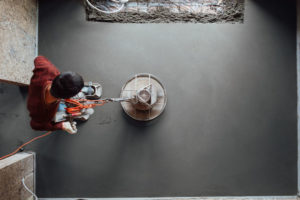
In the world of concrete projects,
walk behind power trowels are very common pieces of equipment used in the finishing process. Trowels come in a variety of different sizes, and even ride-on power trowels are available. If you’re unfamiliar with how to use a walk-behind trowel, this run down should help you get acquainted with the particulars of safe operation for your concrete projects to come.
Getting To Know the Equipment
Most walk behind trowels are gas powered, and as such there are some important things to remember before you start them up. Make sure the machine has a sufficient amount of engine oil, and check the gearbox oil as well. Some trowels have gearboxes with view areas that make this a simple check. You’ll also want to ensure your spider arms are greased properly before every use. Staying on top of these simple maintenance items will help keep your power trowel in great working condition.
Starting the Power Trowel
Start the engine, remembering to use the choke if the engine is cold. Most power trowels will start without any throttle use, and will idle without spinning blades. After starting the engine, it’s time to get the blades going too. To achieve this, you increase the speed by adjusting the throttle control on the handle. The blades should start to spin on the floor, and you can adjust their speed with throttle control.
Walk-Behind Trowel Operation
Once the engine is on and the blades are spinning, you’ll be able to get a feel for how the trowel steers. Move the unit to the right by applying a little pressure on the handle. Conversely, lift the handle to move the unit to the left. These are the basics of trowel steering. The more you operate it, the better feel you’ll get for the amount of pressure required to change directions and steer the unit effectively.
One thing to consider is that the trowel will handle differently depending on the type of surface it’s on. When on dry concrete, there is much less resistance than on wet concrete, so the experience of steering will differ greatly. This is definitely a learn by experience kind of task, and the more practice you have with the walk-behind trowel, the more effectively you’ll be able to control it. Best of luck with all your concrete projects, and
contact our team at Power Rental & Sales with questions or product needs!
 In the world of concrete projects, walk behind power trowels are very common pieces of equipment used in the finishing process. Trowels come in a variety of different sizes, and even ride-on power trowels are available. If you’re unfamiliar with how to use a walk-behind trowel, this run down should help you get acquainted with the particulars of safe operation for your concrete projects to come.
In the world of concrete projects, walk behind power trowels are very common pieces of equipment used in the finishing process. Trowels come in a variety of different sizes, and even ride-on power trowels are available. If you’re unfamiliar with how to use a walk-behind trowel, this run down should help you get acquainted with the particulars of safe operation for your concrete projects to come.
 In the world of concrete projects, walk behind power trowels are very common pieces of equipment used in the finishing process. Trowels come in a variety of different sizes, and even ride-on power trowels are available. If you’re unfamiliar with how to use a walk-behind trowel, this run down should help you get acquainted with the particulars of safe operation for your concrete projects to come.
In the world of concrete projects, walk behind power trowels are very common pieces of equipment used in the finishing process. Trowels come in a variety of different sizes, and even ride-on power trowels are available. If you’re unfamiliar with how to use a walk-behind trowel, this run down should help you get acquainted with the particulars of safe operation for your concrete projects to come.